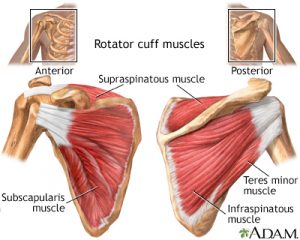Brian Schiff’s Blog
Injury Prevention, Sports Rehab & Performance Training Expert
It is that time of year where baseball pre-season throwing is ramping up. I am starting to see throwers coming in to my clinic with shoulder and elbow issues. In many cases, injury can be avoided with proper stretching and strengthening as well as effective loading programs.
Pectoralis major/minor and latissimus muscle tightness along with poor scapular control often leads to postural dysfunction and shoulder problems. Improving shoulder mobility and scapular control can reduce injury risk and shoulder strain.
The video below from one of my Functional Fit columns will demonstrate an excellent exercise that can be programmed for every thrower to aid in optimizing shoulder mobility and promoting shoulder health.
I often use this exercise following soft tissue release techniques and in conjunction with thoracic spine extension mobilization on the roller. It is an excellent warm-up and activation exercise.
The Backstory
It all began with a burning sensation in my left shoulder in November 2020 with a simple gesture. I did not give it a second thought, as it subsided in a few minutes. However, I soon began to notice more regular pain with certain movements and difficulty sleeping at night. Honestly. I thought it would subside and chalked it up to some mild rotator cuff inflammation. For years, I had avoided overhead lifts and heavy bench press, while restricting range of motion to reduce stress on my shoulders. With that said, this pain led to me further modifying my workouts.
A few weeks later, the nocturnal pain became more intense and prevalent. I knew it was time to formally rehab my shoulder. So, I did what I would advise my patients to do. I embarked on 6 weeks of rotator cuff and scapular strengthening 3x/week, while using laser, ice, and non-steroidal anti-inflammatory meds to resolve the pain. I stuck religiously to this plan from mid December to the end of February. Unfortunately, nothing helped. Sleeping was interrupted consistently, and my function was limited.
As such, I sought the counsel of a trusted surgeon I work closely with. He ordered an MRI, which revealed a 1 cm near full-thickness tear in the supraspinatus tendon, a type II acromion and a big anterolateral bone spur. As you can see from the list below, I have a borderline medium-size tear.
Rotator Cuff Tear Classification:
Small < 1 cm
Medium 1-3 cm
Large 3-5 cm
Massive > 5 cm
Shoulder pain is one of the most common issues I treat in my clinic week to week, There are many causes of pain, but the most common cause of shoulder pain in active individuals typically involves the rotate cuff. These relatively small muscles are called upon to manage high and repetitive loads during sports, work and daily activity.
In some cases, there is just mild inflammation that does not limit function. In there cases, there is more acute pain that makes it hard to even raise the arm or use it for the most basic things. It can be difficult to really discern if there is significant injury as even acute tendinitis can be debilitating.

Image courtesy of Medline Plus
In a blog post I wrote for my work site, I discuss the differences between tendinitis, tendinosis and tears of the rotator cuff. Click here to read more.
If you have rotator cuff pain and are looking for a simple at-home rehab plan or injury prevention program, check out my training guide at www.rotatorcufftraining.com.
This is a follow-up from my previous post. Limited thoracic spine rotation can be detrimental for the shoulders, low back and lower extremities with sports and strength and conditioning activity. Consider the impact of asymmetry or stiffness on a golfer, swimmer, thrower, tennis player or even someone doing rotational and pressing working the gym.
Asymmetrical and repetitive activity can lead to deficits as can faulty positions during work and daily life. This simple exercise with the foam roller can be helpful in facilitating optimal mobility and better kinetic chain motion. This video comes from my ‘Functionally Fit’ column for PFP Magazine.
I work with many weekend warriors, strength training enthusiasts and overhead athletes in my practice. One of the more common dysfunctions I see in this population is either asymmetrical or general thoracic spine hypomobility (decreased range of motion).
This can predispose you to shoulder, back and hip dysfunction, as well as increase the risk for overuse injuries. In addition, it may also alter the natural biomechanics of movement, thereby negatively impacting performance. With all the sitting and screen time we engage in, it is no surprise we are developing a generation of people with forward heads, rounded shoulders and kyphotic posture.
This leads to reduced thoracic spine extension. Additionally, I often encounter decreased thoracic spine rotation. If this becomes restricted, asymmetrical overhead athletes may face increased stress on the lumbar spine, hips and glenohumeral joint. Common dysfunctions I treat related to this is rotator cuff tendinopathy, labral pathology, mechanical back pain, and hip pain to name a few.
To combat stiffness and promote more optimal mobility, I encourage my clients to perform daily mobility work. I have included a video I filmed for PFP Magazine in my column ‘Functionally Fit’ below that illustrates an effective way to combat reduced T-spine extension.
Be sure to check back for my next blog post on how to increase thoracic spine rotation.

